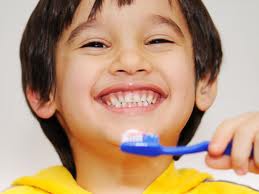Let's Make This A Happy Visit
 The first visit to the pediatric dentist should be easy and fun, both for the child and the parent. It is really important to get a thorough medical history from the parent. The medical and sometimes family history will enable the pediatric dentist to learn a great deal about the patient. Besides written documentation, a meaningful conversation with the parent is really essential in understanding the patient. Many intake forms are lacking the personal touch which a young child and parent need. Usually, behavior, diet, familial medical and dental history are better related through a conversation. The family can express in their own words their expectations as well as offer information on the child's development. I have found that parents, when given the opportunity to express their views, are happy to be brought into the examination and treatment process. As the parents become more relaxed the child will often relax as well.
The first visit to the pediatric dentist should be easy and fun, both for the child and the parent. It is really important to get a thorough medical history from the parent. The medical and sometimes family history will enable the pediatric dentist to learn a great deal about the patient. Besides written documentation, a meaningful conversation with the parent is really essential in understanding the patient. Many intake forms are lacking the personal touch which a young child and parent need. Usually, behavior, diet, familial medical and dental history are better related through a conversation. The family can express in their own words their expectations as well as offer information on the child's development. I have found that parents, when given the opportunity to express their views, are happy to be brought into the examination and treatment process. As the parents become more relaxed the child will often relax as well. Your child's lifetime of preventive care starts now. My earlier blogs discussed several topics which are important in understanding the need for routine dental visits. We want to make "going to the dentist" a routine and pleasant experience for everyone, even fun. I recently took a continuing education lecture given by The American Academy of Pediatric Dentistry. One of the topics discussed was prevention with Pre-Natal counseling for the expectant mother. It's not too early to learn about preventing dental disease for your child. Also discussed in the lecture was the concept of risk assessment for the young developing child. That is why we must have a frank and informative conversation with parents.
Your child's lifetime of preventive care starts now. My earlier blogs discussed several topics which are important in understanding the need for routine dental visits. We want to make "going to the dentist" a routine and pleasant experience for everyone, even fun. I recently took a continuing education lecture given by The American Academy of Pediatric Dentistry. One of the topics discussed was prevention with Pre-Natal counseling for the expectant mother. It's not too early to learn about preventing dental disease for your child. Also discussed in the lecture was the concept of risk assessment for the young developing child. That is why we must have a frank and informative conversation with parents.So what is going to happen in those first early visits to the pediatric dentist? The most important part of the initial exam is allowing the parent to part of the process. Getting parents on board really helps the child feel comfortable. It is the parent's understanding of their child's health needs and the nature of dental disease, especially early childhood caries, that will allow their child to accept and respect the dental exam as part of the prevention of disease. These first examinations are often performed with the child sitting on the parents lap, talking and explaining, with the least amount of instrumentation as possible. I found that plastic mirrors work best. They are not cold and also do not fog up quickly. They also come in colors! But first let's just try to look at your child and into your child's mouth. Gauze or cotton rolls are soft and can clean surface debris. Besides checking teeth, we must also examine the soft tissues, gums, cheeks and tongue. The visit for these young children will be non-invasive. Nothing "bad" happened and they got a present, toy, toothbrush or both. If the first visit is performed early enough, performed on a regular basis, and the preventive care followed, cavities can be largely prevented.
Parents are the most important factor in preventive dental care. They should be an active participant and advocate for their children, even prenatally.
On that first happy "visit to the dentist" a plan for preventive care and possibly modifying diet and behavior will be designed to best help your child.
Thank you all for your positive feedback and suggestions. I received some great comments from other pediatric dentists describing how they go about making the first dental visit easy for their patients.




